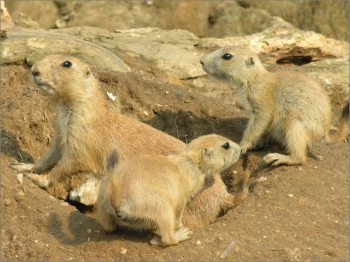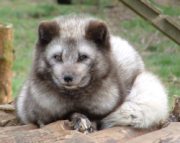|
|
|
|
Raccoon (
Procyon lotor )
The raccoon is a reddish-brown above and black or greyish below. The most prominent characteristics are the bushy tail with 4-6 black or brown rings and the black mask outlined in white. The ears are small and the feet and forepaws are dexterous.
The racoon is found primarily in broadleaf woodland and wetland areas near rivers and streams. They like to be close to water and drink every day. They prefer to wash their food between their front paws before eating it. |
Raccoons belong to the family procyonidae. Other species in this family include the coati, ring tailed miners cat, kinkajous, olingo and cacomistle. They are seen by many to resemble dogs and cats but are in fact related to neither. Racoons are classified as carnivores but are more omnivorous in nature and will feed on grapes, nuts, grubs, crickets, small mammals, birds' eggs and nestlings.
Spread throughout the Americas and introduced to some parts of Europe and Asia the seven species of racoon include the common racoon of North America and the crab eating racoon of South America. Generally nocturnal they are seldom seen in the wild but can become pests in urban areas as they are very tolerant to human activity. |
|
 |
|
|
Meerkat (Suricata suricatta )
Meerkats are part of the mongoose family They live in southern Africa (Angola, Namibia, South Africa and southern Botswana). They have a tan to grey coat with brown bands on the back and sides. They head and the throat are greyish white. They eyes are ringed with black and they have black rounded ears and a black tip to the tail. Like all mongooses, they have long slender bodes and short limbs. They are about 25-35cm (10-14in) long, and weigh around 600-975g (21-35oz). They feed mainly on insects, spiders and other small animals, as well as roots, fruit and bulbs. |
Meerkats are sociable animals and live in large groups of up to 30. The groups consist of 2-3 family units comprising a male, a female and their 2-5 young. They live in extensive burrow systems underground and will often use the burrows of ground squirrels, which they enlarge by digging with their sharp claws. When emerging from their burrows in the early morning, they tend to sunbathe before spending the day foraging for small prey. Adults take it in turns to stand on sentry, finding a convenient vantage point where they can watch for predators, such as eagles. The black hair around their eyes enables them to scan the bright sky for predators. If danger is sighted, the sentry gives a warning bark, and the meerkats flee to the safety of their burrows. If the threat is a snake, the adults will huddle together and drive the predator away.
Meerkats will breed regularly and after a gestation period of 11 weeks, females give birth to 2-5 young in a nursery chamber of the burrow. The care of the young is shared between family members and babies will regularly be looked after by an auntie or older sibling while the mother is away foraging for food. |
|
|
|
 |
Prairie Dog ( Cynomys ludovicianus )
Prairie Dogs are the most social members of the Squirrel Family and are closely related to ground squirrels, chipmunks and marmots. They tend to live in very large colonies called ‘towns' and one study in 1900 identified a settlement in Texas of some 400 million prairie dogs in an area covering hundreds of miles. There are 5 species of Prairie Dogs Black-tailed, White-tailed, Gunnison's, Mexican and the Utah Prairie Dog, which is a threatened species |
The Black-tailed Prairie Dog is so called because it has a black-tipped tail occupies narrow bands of dry plains stretching from central Texans to Canada and is much more widespread than it's cousins. Prairie Dogs are robust little rodents and typically have broad, rounded heads, hairy tails and short legs. They weigh 1 1/2 to 3 lbs and are approximately 11 to 13 inches long. They are yellow/brownish in colour, with darker ears and a pale buff to whitish belly. Prairie Dogs are very vocal and have a high-pitched, bark-like call. Recent studies suggest that Prairie Dogs possess the most sophisticated of all natural animal languages. They apparently issue different sounds identifying various predators, which include hawks, owls, eagles, ravens, coyotes, badgers, ferrets and snakes. Similar to the Meerkat above, the Prairie Dog has a very effective form of defense i.e. raise the alarm and disappear quickly. Common predators of the Prairie Dog include coyotes, bobcats, eagles, hawks, badgers and weasels.
The Prairie Dog lives in well-constructed burrows with funnel shaped entrance holes raised above the ground to prevent flooding. These tunnels are very long and may extend to 100 feet or more.
Although Prairie Dogs are almost exclusively vegetarian and their diet consists of all kinds of grasses, roots, weeds and blossoms. They acquire all of their water from the food they eat. Sometimes insects are also eaten. For the Black-tailed, mating generally occurs in late January, with the young being born in March and April (a gestation period of 28 to 32 days). There are usually 3 to 5 youngsters in a litter, but sometimes as many as 8.
For decades Prairie Dogs have been treated as pests due to their ability to devastate crops and vegetation. Eradication programs have greatly reduced numbers and they only inhabit about 2 percent of their former range.
|
|
|
 |
Mara (Docilchotis patagonum)
(Patagonian Cavy)
The Mara, closely related to the guinea pig, looks like a cross between a rabbit and a small deer, with short brown fur, a dark rump and white belly. It has a broad deep muzzle and large eyes and ears and and relatively long thin legs. It is approximately 50-75cm long with a 4.5cm tail and weighing 8-9kg |
|
The Mara inhabits the scrub desert and grassland of Central and southern Argentina and feeds exclusively on grasses and herbs. Maras are one of the few mammals that are monogamous (pairs mate for life). The young are kept in a communal burrow called a creche. As many as 15 pairs of maras may deposit their young in one creche. Although pups are well developed and can start grazing within 24 hours of birth, they remain in the creche for up to four months.
Maras live most of the year in pairs, and defend a home range of about 40 hectares and are rarely seen in larger aggregations except around water. In the breeding season about 15 pairs congregate at a communal den, dug by the females, although the individuals are still wary of each other and try to avoid meeting.
Females give birth to 1-3 young after a gestation of 90 days. Within a day the pups start grazing and wandering from the burrow, but they stay close by in the early months, and the mother will return to nurse them once or twice a day. All the pups will greet a returning mother, but she will sniff out her own young and only suckle those, whilst the male stands guard, keeping other returning pairs at bay. At larger dens there is often one pair standing guard at all times. |
|
|
 |
Arctic Fox
(Alopex lagopus)
The arctic fox is found in the far north, mainly in the Arctic Circle, on Iceland and on the coast of Greenland. It lives in a den or burrow dug into the side of a hill, cliff or riverbank. In winter it digs connecting tunnels in the snow so several families can live together. They often hunt in small groups during the winter.
They are well adapted to to living in icy temperatures and do not need to hibernate.
|
|
These animals are quite small (about the same weight as a cat) with short legs and short rounded furry ears. The bushy tail is about 30 cm. long. And it's thick coat makes it look much larger than it really is. During late spring and summer the coat turns a grayish brown and becomes quite thin and unattractive, but thickens up again during late summer when the fur turns gray and then white. The oily fur sheds water and helps to keep the fox dry.
The female can produce between 4 to 11 pups twice a year, although an average litter is normally 6 or 7 pups. The babies are born in a den or burrow in late spring. Baby foxes are about the size of a kitten and both parents take care of the blind cubs. At three weeks the cubs eyes are open and they begin to explore outside the den. The parents have to work hard to feed their growing family and by the time their family is almost grown, the parents feed them over a hundred lemmings a day! Thankfully the parents teach their young how to hunt for themselves and are soon independent. Eventually the young males will leave the family and form their own groups but the females stay with the family group.
They prey on voles, lemmings, hares, ground squirrels, birds and birds' eggs. Foxes that live near the coast feed on shellfish, sea urchins and other shore animals. They check the shoreline for dead seals, whales, and dead fish . When meat is not available the Arctic fox eats fruit and berries. The Arctic fox will even kill baby seals if it can find the den in the snow. In the summer the fox will hide food in its den or under rocks to store it for later use. The favourite method for catching prey is to walk along listening for small animals running under the snow. When they hear something, they jump up and down to break through the snow with their front paws then grab their prey before it disappears again.
Arctic foxes are preyed upon by Polar bears and trappers who want their beautiful fur to make coats. Fortunately the fox can run quickly and is well camouflaged particularly in the winter when its thick, bushy coat makes it very hard to see against the white background so affords it some protection. |
|
 |
Register your e-mail address and receive regular bulletins on news and events. |
|
Contact Us if you belong to a local group and want special rates for your visit. |
|
| Let Us Know if you'd like to celebrate a special event with us. Our Barbecues are Great!! |
|
|
Telephone: |
|
|
|


